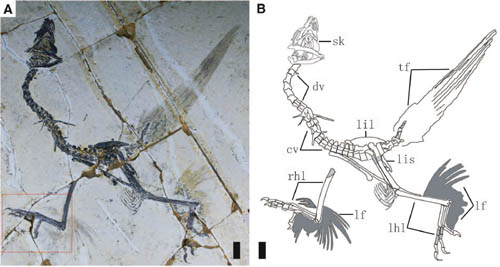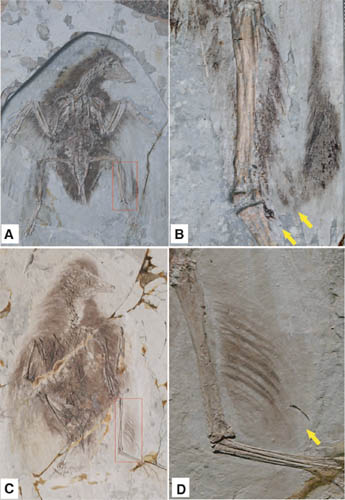| Location: Home > Research > Research Progress |
| New Finding Confirmes the Presence of a Four-winged Condition in Early Birds |
|
Recent discoveries of large leg feathers in some theropods have implications for our understanding of the evolution of integumentary features on the avialan leg, and particularly of their relevance for the origin of avialan flight. However, no examples of this unusual structure have so far been reported in early primitive birds. Scientists from the Institute of Vertebrate Paleontology and Paleoanthropology (IVPP), Chinese Academy of Sciences, and Shandong Tianyu Museum of Nature and Institute of Geology and Paleontology of Linyi University, described 11 specimens of different bird species that preserve exceptional integumentary structures associated with the hindlimb, and confirmed the presence of a four-winged condition in early birds. Their study demonstrates a distal-to-proximal reduction pattern for leg feathers in avialan evolution, and suggests that extensively scaled feet might have appeared secondarily at an early stage in ornithuromorph evolution. Researchers reported March 15 in Science (339).
All 11 specimens are from the Lower Cretaceous Jehol Group and are housed in the Shandong Tianyu Museum of Nature (STM). Among them, two are referable to the basal avialan Sapeornis, in which a series of parallel pennaceous feathers (feathers with stiff vanes) was observed along the distal half of the tibiotarsus and nearly the whole length of the metatarsus in each hindlimb. Five confuciusornithid specimens contribute significant new information, in which large pennaceous feathers occured along nearly the whole length of the tibiotarsus, although the leg integument is poorly known in confuciusornithids. Three specimens are referable to the Enantiornithes and probably belong to two different taxa, in which regularly arranged large feathers are preserved along the whole length of the tibiotarsus. These specimens provide further support for the existence of a reduced hind wing in enantiornithines, as in most bird specimens from Liaoning, no integumentary structures are preserved in association with the feet. One specimen is referable to Yanornis, which is the first known basal ornithuromorph specimen with both feathers and scales well preserved on the legs. Large metatarsal feathers were first discovered in the basal dromaeosaurids Microraptor and Sinornithosaurus, and were subsequently reported in the enigmatic Pedopenna and the basal deinonychosaurians Anchiornis and Xiaotingia, and can now also be definitively said to occur in the basal avialan Sapeornis. The morphology of the metatarsal feathers shows considerable variation among taxa known to possess these structures. In Microraptor, the metatarsal feathers are proportionally large with highly asymmetrical vanes, whereas in Pedopenna, Anchiornis, and Sapeornis they are proportionally smaller and have nearly symmetrical vanes. In all cases, however, the metatarsal feathers are similar in general arrangement (nearly perpendicular to the metatarsus, forming a large flat surface) and in having stiff vanes and curved rachises. These features suggest that the metatarsal feathers were aerodynamic in function, providing lift, creating drag, and/or enhancing maneuverability, and thus played a role in flight. “The presence of metatarsal feathers with a probable aerodynamic function in both deinonychosaurians and avialans strongly supports the interpretation that leg feathers were an important factor in the origin of avialan flight, although the nature of their biomechanical contribution to flight ability is debated”, said corresponding author XU Xing of the IVPP. According to the study, metatarsal feathers are also known in several other coelurosaurian dinosaurs, although in these cases they take the form of short filaments rather than large pennaceous feathers. Short filamentous feathers have been reported to cover the metatarsus of the compsognathid Sinocalliopteryx, and similar feathers are also seen near the metatarsus of one specimen of the tyrannosauroid Yutyrannus. Metatarsal feathers are unknown in some other coelurosaurians that clearly bear femoral and crural feathers, such as the therizinosauroid Beipiaosaurus, the oviraptorosaurians Protarchaeopteryx and Caudipteryx, and enantiornithines. However, extensively scaled feet are unknown in any nonornithuromorph coelurosaurian specimen. Therefore, the lack in these taxa of known pedal feathers, including metatarsal ones, may be best regarded as a case of absence of evidence (perhaps resulting from the vagaries of preservation) rather than evidence of absence. Consequently, the discovery of Yanornis, in combination with data from other recently reported coelurosaurian fossils, implies that feathered feet might be primitive for the Coelurosauria, and extensively scaled feet might have appeared secondarily at an early stage of ornithuromorph evolution. “Although early bird flight might initially have involved four wings, the locomotor system of ornithuromorph birds is characterized by a combination of flight using feathered arms and bipedal terrestrial locomotion using the legs. The reduction and loss of distal feathers on the legs reflect decoupling of the forelimbs from the hindlimbs in the locomotor system of ornithuromorph birds, in which the arms became specialized for flight and the legs for terrestrial locomotion”, said first author ZHENG Xiaoting, Tianyu Museum of Nature and Institute of Geology and Paleontology of Linyi University. This work was supported by the National Natural Sciences Foundation of China, the National Basic Research Program of China, and the Chinese Academy of Sciences. Fig.1 Leg feathers in the basal avialan Sapeornis. Photograph (A) and drawing (B). (Image by ZHENG Xiaoting) Fig.2. Leg feathers in the basal avialan Confuciusornis (A, B) and the enantiornithine Cathayornis (C, D). (Image by ZHENG Xiaoting) Fig.3. Integumentary features of the hindlimb in the basal ornithuromorph Yanornis. (A) Photograph of STM9-5. Pedal integument of STM9-5 as seen in the slab (B) and counter slab (C). Femoral and crural feathers of STM9-5 as seen in the slab (D) and counter slab (E). (Image by ZHENG Xiaoting) Fig.4 An artist's reconstruction of Sapeornis. (Image by LI Rongshan) |



